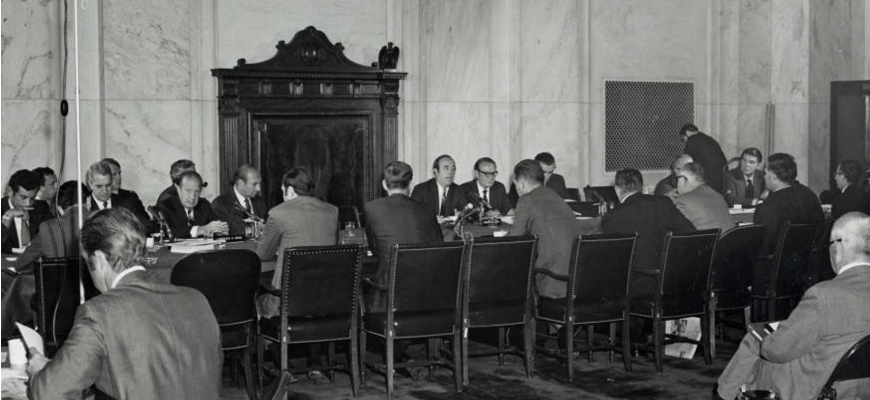
DONALD F. KETTL, SEPTEMBER 15, 2020
A tiny agency did important work on our intergovernmental system for decades. It’s unlikely that the Advisory Commission on Intergovernmental Relations can be revived, but we still need what it did.
A small band of federalism fans has been plotting for some time to bring the old Advisory Commission on Intergovernmental Relations back to life. There seems to be little hope they’ll be able to re-create the old tunes, but the effort is a worthy one: We need the kind of forum the ACIR provided as much as ever.
The ACIR was part of the federal government for the better part of four decades. An independent agency, its mission was to “study how different levels of government interact with one another, and attempt to define how they should interact with one another in the context of the Constitution.” These days, it lives on mainly in the memory of those who worked with it and in its early Internet home page housed in a “cybercemetery” at the University of North Texas.
It was a standing commission of 26 individuals: half a dozen members of Congress, four governors, three state legislators, four mayors, three county officials, three members of the executive branch and three private citizens. The commissioners were heavy hitters, including feds like the head of the Environmental Protection Agency and the secretary of education, the president’s director of intergovernmental affairs, and distinguished scholars like Richard P. Nathan, the former director of the Rockefeller Institute of Government.
With that kind of a political base, dealing with issues that affected every state and local government in the country, its support once seemed ironclad. President Eisenhower called its birth in 1959 “an historic undertaking,” one that, among other things, would focus on “the elimination of frictions, duplications and waste from Federal-state relations.” The ACIR was always a tiny agency — its annual budget ranged from $1 million to $2 million, with a staff ranging from 20 to 50 — but for a long time it punched far above its weight.
In the 1990s, however, its role and leverage gradually eroded. Attendance at commission meetings began to drop off. The ACIR ran afoul of the Clinton administration with its research pointing out the rising cost of federal mandates on state and local governments, and the rise of partisan polarization shredded any remaining political support for the agency. Under then-House Speaker Newt Gingrich, Republicans were looking for government agencies to abolish and, despite its small size, the ACIR ended up on their target list (along with other small but valuable creatures like Congress’s Office of Technology Assessment).
The ACIR closed down in 1996, and fans of federalism have been debating how to bring it — or something like it — back ever since. They yearn for the heyday of the ACIR in the 1960s and ’70s, a golden age of federalism from Lyndon Johnson’s Great Society to Richard Nixon’s New Federalism. Those were years of bold policy innovations like Medicaid, Model Cities, General Revenue Sharing and a collection of block grants, and they all grew out of a federal commitment to genuine partnership with state and local governments.
As governors began traveling to Washington more frequently, however, they developed a stronger voice in the process and found they didn’t need a commission to speak for them. And in any event, they spoke less and less with one voice, as the states became more politically polarized and moved in very different directions on issues ranging from health care to welfare. Meanwhile, the “Big Seven” group of state and local government interest groups also has come to speak much less with one voice, so it became hard to gather them all under one umbrella.
Much of the real heft of the ACIR’s work came from its data collection and policy studies. I was always a big fan of its “Significant Features of Fiscal Federalism” series. But the ACIR found that there’s no such thing as politically neutral data. It created a storm, long before pandemic-fueled online buying, with its estimates of how much tax revenue states were losing to mail-order businesses. Private firms and nonprofit organizations have since stepped in to provide invaluable data collection, from Moody’s Analytics’ assessments of fiscal stress to Johns Hopkins University’ cross-state coronavirus comparisons, but the kind of policy research on federalism that the ACIR performed has shriveled.
The cross-pressures that led to the ACIR’s demise 24 years ago have only increased since then, and that makes it even harder to dream of getting the band back together. A former executive director of the ACIR, John Kincaid, sadly concluded back in 2011 that “a new ACIR or even a narrowly tailored technical ACIR is unlikely to rise from the dead,” and that’s become even more true since.
We’re no doubt much poorer for the loss of the ACIR. But its death decades ago — and the failure to bring it back to life since — is a sign of the widening divide between the federal government and the states, and among the states themselves, that no single organization can bridge. It sure would be healthy, though, to have a forum in which to debate these questions — and a common language, fueled by a pool of rich data, with which to have the conversation.
This article by Don Kettle (kettl@austin.utexas.edu | @DonKettl) originally appeared in Governing.Com: A Forum for Federalism That’s Sorely Missed.
Image credit: Meeting of the U.S. Advisory Commission on Intergovernmental Relations, 1970 (General Services Administration / Courtesy of the Westchester County Archives).
